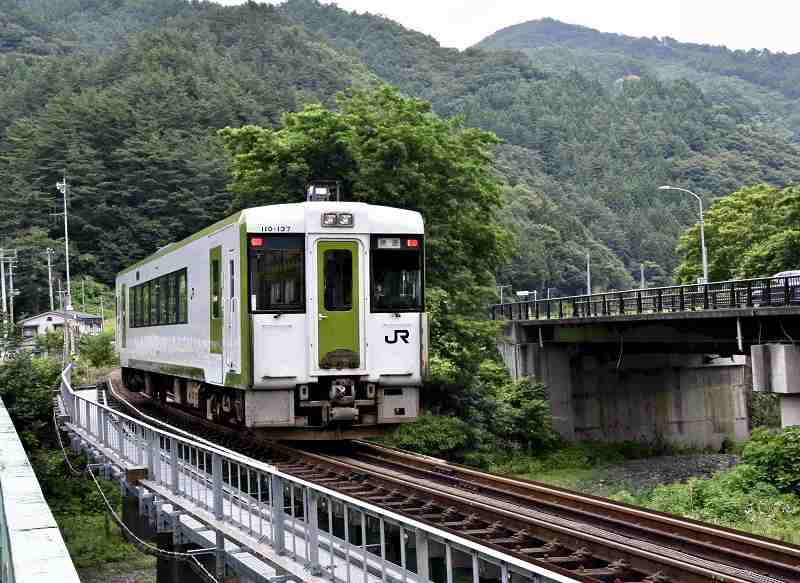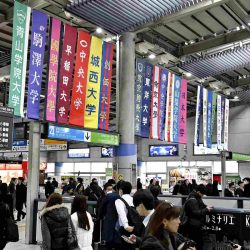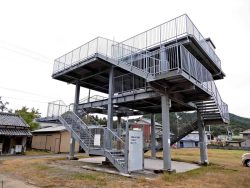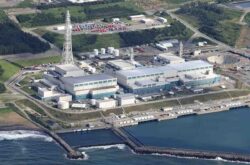
A train runs through Miyako, Iwate Prefecture, on the JR Yamada Line, of the lines for which a severe financial situation has been recently announced.
20:00 JST, July 29, 2022
East Japan Railway Co. (JR East) on Thursday said that 35 regional lines, accounting for a third of its total conventional line length, were all in the red in fiscal 2019, posting a total deficit of ¥69.3 billion, in the railway company’s first separate announcement of income and expenses for local lines with fewer passengers.
The decline in railway users in rural areas is a nationwide problem. The severe impact of the novel coronavirus pandemic has deprived railroad operators of the capacity to financially support their unprofitable lines. The latest announcement will likely expedite moves to examine how to realize more sustainable public transportation systems in relevant areas, such as by shifting to bus services.
Thursday’s announcement covered 66 sections on 35 lines that had a transport density of fewer than 2,000 passengers in fiscal 2019, which ended when the impact of the pandemic was relatively small in Japan. Transport density is the daily average of passengers a section carries per kilometer. The latest figures show declines ranging from 30% to 90%, compared to the time of the break-up and privatization of Japanese National Railways (JNR) in 1987.
The 66 sections totaled about 2,200 kilometers, or 35% of the 6,207 kilometers of conventional lines currently operated by JR East.
Of the 66 sections, the Uetsu Line route near the Sea of Japan coast between Murakami Station in Niigata Prefecture and Tsuruoka Station in Yamagata Prefecture had the largest deficit at ¥4.909 billion.
The second-largest deficit was that of the Ou Line section in northern Akita Prefecture between Higashi-Noshiro and Odate stations at ¥3.242 billion.
Third on the list was the Uetsu Line again, for the section from Sakata Station in Yamagata Prefecture to Ugo-Honjo Station in Akita Prefecture, at ¥2.711 billion.
JR East had been using profits from conventional lines in the Tokyo metropolitan area as well as Shinkansen lines to make up for deficits on unprofitable railways in rural areas, but passenger numbers on these mainstay lines have also declined due to the pandemic, resulting in net losses for a second consecutive term.
“We concluded it was necessary to disclose the figures to help people understand the actual situation, not only using words to say how difficult it is,” JR East executive officer Takashi Takaoka said at Thursday’s press conference, referring to the company’s business situation.
Of the JR companies, West Japan Railway Co. (JR West), Hokkaido Railway Co. (JR Hokkaido), Shikoku Railway Co. (JR Shikoku) and Kyushu Railway Co. (JR Kyushu) have already disclosed section-by-section balances of income and expenses for their local lines.
JR West and JR Kyushu announced the figures for their local lines with a transport density of fewer than 2,000 passengers, as JR East has now done.
JR West President Kazuaki Hasegawa has said that it will be “extremely difficult to maintain the operation of these lines on their own,” with passengers having declined to this level.
On Monday, an expert panel of the Land, Infrastructure, Transport and Tourism Ministry proposed that the central and local governments and railroad companies establish a mechanism to discuss whether to abolish lines with a transport density of fewer than 1,000 passengers. It also expects each JR company to narrow down candidate lines for discontinuation and reach a conclusion within three years.
However, regarding the lines with a transport density of fewer than 2,000 passengers, or even 1,000, relevant local governments have voiced their opposition and urged caution against discussions that lean toward abolition. It is likely that such discussions will see rough going.
"Society" POPULAR ARTICLE
-

M4.9 Earthquake Hits Tokyo, Neighboring Prefectures
-

Israeli Tourists Refused Accommodation at Hotel in Japan’s Nagano Pref., Prompting Protest by Israeli Embassy and Probe by Prefecture
-

M7.5 Earthquake Hits Northern Japan; Tsunami Waves Observed in Hokkaido, Aomori and Iwate Prefectures
-

Tsukiji Market Urges Tourists to Avoid Visiting in Year-End
-

High School in Kyoto Says Students Shoplifted during Recent School Trip to Bali, Indonesia
JN ACCESS RANKING
-

Tokyo Economic Security Forum to Hold Inaugural Meeting Amid Tense Global Environment
-

Keidanren Chairman Yoshinobu Tsutsui Visits Kashiwazaki-Kariwa Nuclear Power Plant; Inspects New Emergency Safety System
-

Imports of Rare Earths from China Facing Delays, May Be Caused by Deterioration of Japan-China Relations
-

University of Tokyo Professor Discusses Japanese Economic Security in Interview Ahead of Forum
-

Japan Pulls out of Vietnam Nuclear Project, Complicating Hanoi’s Power Plans
























